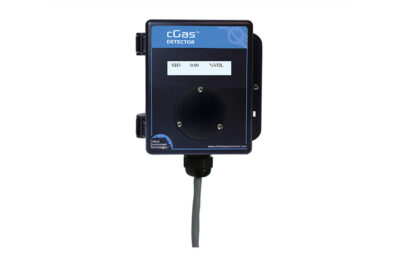cGas Detector Ammonia Vent Line Transmitter

For continuous monitoring of Ammonia levels in the vent line of refrigeration systems
Mount indoors on the ammonia vent relief stack in refrigeration systems to help detect equipment failure
Applications
- Ice Arenas
- Refrigeration Plants
- Cold Storage Rooms
- Freezer Rooms
- Ammonia Plants
- and many more…
Key Features
- Single channel, internal catalytic Ammonia sensor
- 4-20 mA analog output or user configurable in the field, BACnet® MS/TP (version 1 rev 14) RS-485 or Modbus® RTU (version 1.1b3) RS-485
- 24 VDC or VAC power (ground referenced)
- Easy Plug & Play Smart Sensor replacement at end of life, comes pre-calibrated
- Bright LCD display
- USB port for configuration changes and firmware upgrades
- Optional 2A SPDT dry contact relay (Option -RLY)
- Optional low temperature operation package (Option -LT)
- Standard water / dust tight, corrosion resistant enclosure (drip proof)
- Thermal resetting fuses
- RoHS compliant circuit board
Description
The cGas Ammonia Vent Line Detector is designed for continuous monitoring of ammonia levels in the vent line of refrigeration systems, including the detection of equipment failure in ammonia plant vent stack applications. Using a a ¾” cast steel coupler, the cGas Ammonia Vent Line Detector is to be mounted indoors on the ammonia vent relief stack above the pressure relief valve.
With the optional relay, it can be configured to send an analog signal to the controller or PLC to activate the emergency ventilation system or shut down the equipment depending on the level of alarm.
Powered by 24 VDC or ground referenced AC, the CGAS Detector has an LCD display and the firmware and configuration can be upgraded in the field using the USB connection. The Plug & Play Smart Sensor comes pre-calibrated and is easy to replace.
It comes standard with a water / dust tight, corrosion resistant ABS / polycarbonate enclosure with a hinged, secured door. A factory installed splash guard protects the device against water ingress.
NOTE: This device is not designed to monitor ammonia in applications requiring human health safety levels detection. The lowest reading the sensor will detect is above the recommended exposure limit to ammonia. A large release of a high concentration of ammonia may burn out the sensor and it will require replacement.

